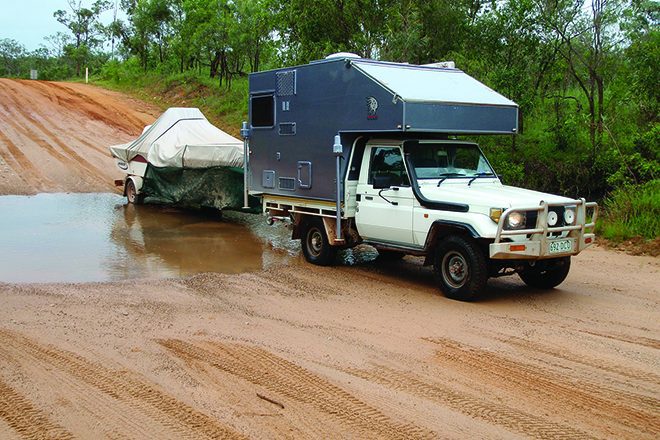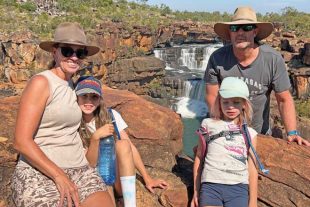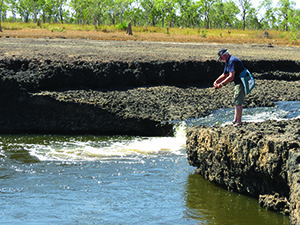
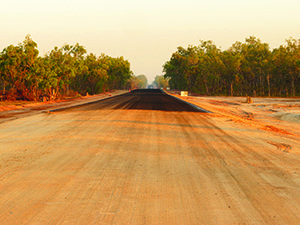
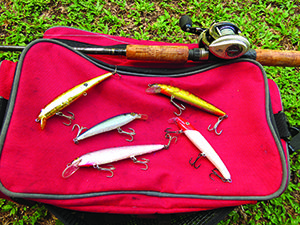
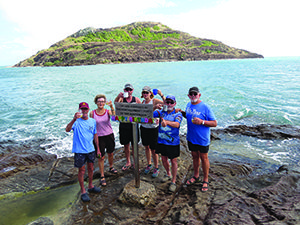
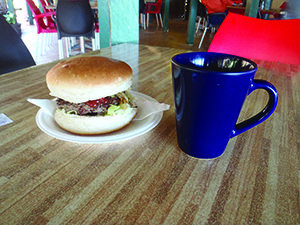
I’VE now lived on Cape York for more than 30 years, so I reckon I just about qualify to be called a local!
As somebody who has been up and down the main access track, officially known as the Peninsula Development Road, many times, it is often very amusing to read some of the questions posed by those who are planning and gearing up for their first expedition, particularly on Facebook groups such as ‘Cape York Adventures’ and ‘Cape York’s Awesome Adventures’.
There’s no doubt preparing for a ‘bucket-list’ foray to remote parts previously unknown can be a somewhat daunting task given the propensity for media sensationalism these days. However, reality is often a much less formidable event, simply requiring plenty of common sense and some basic research to get to your chosen destination. You can’t find out if you don’t take the plunge!
It’s OK to be cautious but not to the extent that you start stressing out. Those who are well prepared, barring serious mishaps, will breeze through a Cape traverse, enjoy the countryside and wonder what all the fuss was about.
It’s the few who treat the trip as a drive to the supermarket and expect others to help them out when they get stuck that are the problem. Weipa locals, for instance, routinely jump in their vehicle and drive the 10 hours to Cairns for a bit of shopping and other ‘city’ stuff at least a couple of times per season.gearing up for
As long as your vehicle is mechanically sound, tyres good and recovery gear aboard, it’s just another long drive. Most times, breaking out the tools or even engaging 4WD is not needed.
Of course, it’s a different story if you intend on doing the Telegraph Track or making other off-road excursions. The most important thing to remember is to drive to the conditions. Most of the serious accidents that occur are due to too much speed over corrugated or washed-out sections of the unsealed highway.gearing up for
The same applies, even more so, if you’re heading up the Tele Track. Take it easy, and never drive into water you haven’t checked for depth – plan your creek and river crossings by walking them first and noting the best entry and exit points.
Even the most well-equipped vehicle can come to grief when driven by an idiot (and I’ve come across quite a few over the years). Breaking an axle, drowning a motor or rolling over can ruin a great holiday, or even worse, cause serious injury.
If you are towing camper trailers or boats, be extra careful, as well as checking couplings and wheel bearings regularly. Last year, I witnessed a near-new 4WD ute badly bend its chassis behind the twin cab section while towing a large camper trailer too quickly over a dip south of Archer River.
Regular Cape drivers will always stop and check a vehicle that has stopped on the roadside to see if they need any help. It’s just regular outback courtesy when you are passing through remote locations. Most of the time there’s no help needed but when the occasion arises that you may need a hand yourself, it’s easy to appreciate the need for that custom.gearing up for
In my case, it’s happened a couple of times over the years and that help has been very much appreciated. It’s amazing what some people are carrying in the way of tools and spares.
If you are towing a boat, make sure your trailer is strong enough to handle the rough stuff. While most fishers fit a cover over the top of the hull, it’s also important to protect the bottom from stone chips and the outboard from dust incursion. Shade cloth makes a durable covering for the underside while vehicle mud flaps can reduce the amount of stones reaching the hull.
I find it best to remove the outboard cowl and then cover the powerhead with a heavy plastic bag before securing it once again. A suitable outboard cover can then be fitted over the entire motor, including the propeller.gearing up for
One practice that makes me really cringe is seeing fully rigged rods set in bull bar racks on visiting 4WDs. The reels are invariably coated in a thick red dust after a session on the unsealed sections and would require a comprehensive clean-up to ever operate properly again. I won’t even mention the rod blank abrasion that can happen on those rough roads.
If you are carrying fishing tackle, store the rods in cloth bags inside a capped poly tube and your reels in cloth bags placed in a tackle box or soft pack. Servicing a clogged reel at a remote campsite while the fish are chopping furiously off the beach nearby is sure to put a dampener on your trip. Just like your vehicle, your outboard and fishing tackle should all be freshly serviced before leaving home.gearing up for
As I said before (the legacy of being a Queen’s Scout): be prepared! One of the most-asked questions on the Facebook forums about visiting the Cape is “what is the best time?” Here again, the sensationalist media has much to answer for because the perception seems to be that any traveller before June each year will find the road un-driveable.
Now I know this answer is probably not going to be definite enough for people trying to schedule holidays well in advance, but here goes. Most years, the PDR as far as Weipa will be open in late March or early April, then will remain trafficable until Christmas.
There are exceptions to this rule, of course, particularly when the Cape gets late cyclones or heavy rain events. The latest I’ve seen the road open is early June after cyclone Monica in 2006.gearing up for
However, if you want to experience the best fishing conditions, I’d suggest planning and gearing up for your trip between early May and mid-June, or later in the season from mid-September until November. The bulk of the Cape’s tourist traffic travels between the school holidays in June until the break in September, with hundreds of vehicles on the road each day during July and August.
No matter how well the gravel sections are maintained, the corrugations during peak months can get so bad they’ll shake the fillings out of your teeth and the trade winds will blow a dog off a chain. Well, maybe that’s a bit exaggerated but you get the gist.gearing up for
In any case, the Cape’s weather would have to be the best in the country during winter – perfect for those who are sick and tired of the cold, bleak climes of the south at that time of year. But if you want to avoid the crowds and find the fish a bit more responsive, then coming early or late in the season will normally find more fish interested in your bait or lure.
There is one option that can help avoid any road closures and get you on the water well before even the early birds arrive. Sea Swift offers a barge service that allows your vehicle and boat to be loaded in Cairns and delivered to Seisia or Weipa while you and yours grab the QantasLink flight and wait for delivery. Most parties choosing this option stay for three or four weeks so they can drive back out when the road is trafficable.gearing up for
Another way of getting in early is to hire a guide, mother ship, houseboat or hire boat but make sure you book at least six months in advance to guarantee a spot. Lobbing into town on spec during April and May will normally find every operator fully booked.
As far as tackle goes, three to four outfits will usually cover most of the fishing scenarios you will encounter. For the estuary, creek or lagoon, a medium-action baitcaster rod of about 175cm coupled with a good-quality reel that holds around 130m of 10kg braid would be ideal.gearing up for
As a second outfit, add a fast-taper spin rod of 180cm and a 2500 to 3000-sized eggbeater with 10-12kg braid that is more suited to soft plastics and light baits. For trolling, live baiting and offshore casting, a medium to heavy spin rod of about 2m matched with a 5000 size reel filled with 15-20kg braid will handle most situations. Adding a similar overhead outfit will take care of any problems.
These days, more and more fishers are opting to carry a fly fishing outfit. My recommendation would be a quality 9 weight combo fitted with 20kg braid backing followed by an intermediate line.gearing up for
As far as lures are concerned, loads of information on the subject can be found in mags and on the net, but a few models I wouldn’t be without include the Reidy’s B52, Big B52 and Taipan hard-bodies, Fish Snakz 95mm and 110mm vibes; Bomber Long A 120; Halco Laser Pro 120, Scorpion 90 Deep, Madeye Paddle Prawn, Roosta Poppa 105, metal slices; Berkley Jerk Shads; and Rapala X-Rap 90.
Add some 45lb and 60lb Platypus (or similar) leader, long-nosed pliers to remove hooks from the toothy critters, a lip gripper, braid scissors and a large landing net and you’re just about ready. Remember, if you’re having second thoughts about the challenges of undertaking a Cape trip, just bite the bullet and go!gearing up for
You’ll find all those ‘what ifs’ evaporate once you’re on the road, so much so, that you wonder why the bloody heck you didn’t do it sooner. Life should be full of experiences both good and not so good! Live it while you have the opportunity. It’s terribly boring wrapping yourself in cotton wool!
Good luck gearing up for your Cape York adventure.
 Bush ‘n Beach Fishing Magazine Location reports & tips for fishing, boating, camping, kayaking, 4WDing in Queensland and Northern NSW
Bush ‘n Beach Fishing Magazine Location reports & tips for fishing, boating, camping, kayaking, 4WDing in Queensland and Northern NSW

